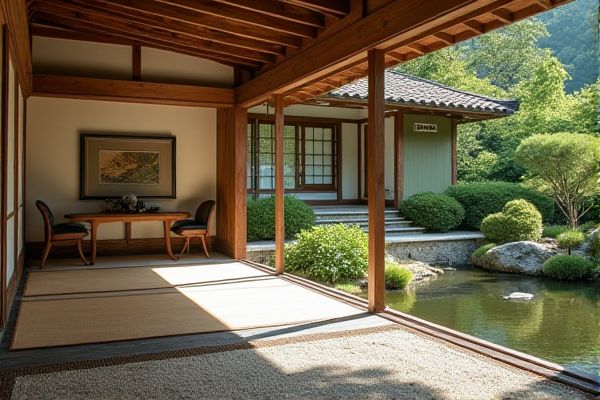
Japanese gardens emphasize natural landscapes with water features, rocks, plants, and pathways to create serenity and harmony, while Zen gardens, also known as karesansui or dry landscape gardens, focus on minimalist arrangements of raked gravel and carefully placed rocks to inspire meditation and mindfulness. Discover how these distinct garden styles can transform Your outdoor space by reading the rest of the article.
Table of Comparison
| Aspect | Japanese Garden | Zen Garden |
|---|---|---|
| Purpose | Recreation, contemplation, seasonal beauty | Meditation, spiritual focus, simplicity |
| Design Style | Naturalistic, detailed, layered | Minimalist, abstract, symbolic |
| Main Elements | Water features, plants, stones, bridges | Raked gravel, rocks, minimal vegetation |
| Plant Usage | Varied trees, shrubs, moss | Limited; mostly moss and small plants |
| Water Presence | Natural or artificial ponds and streams | Usually no water; gravel simulates water |
| Symbolism | Harmony with nature, seasons, life cycle | Zen Buddhism, emptiness, mindfulness |
| Maintenance | Regular pruning and care | Daily raking, minimal plant care |
| Example Locations | Kenroku-en (Kanazawa), Koraku-en (Okayama) | Ryoan-ji (Kyoto), Daisen-in (Kyoto) |
Introduction to Japanese Gardens and Zen Gardens
Japanese gardens embody natural landscapes with ponds, bridges, and seasonal plants symbolizing harmony and tranquility, reflecting centuries of cultural tradition. Zen gardens emphasize minimalist design using rocks, gravel, and raked patterns to evoke meditation and inner peace, rooted in Zen Buddhist philosophy. Understanding these unique elements helps you appreciate the distinct aesthetic and spiritual purposes each garden type serves.
Historical Origins and Evolution
Japanese gardens originated in the Asuka period (538-710 AD) as aristocratic landscapes inspired by Chinese garden design, evolving through the Heian and Edo periods with influences from Shinto and Buddhist aesthetics. Zen gardens, a subset of Japanese gardens, emerged during the Muromachi period (1336-1573) as minimalist dry landscapes designed for meditation, embodying Zen Buddhist principles. Over time, Japanese gardens diversified into various styles, while Zen gardens retained a focus on simplicity and symbolic representation using rocks, gravel, and sparse vegetation.
Design Philosophy and Principles
Japanese gardens emphasize harmony with nature through asymmetry, balance, and natural materials, creating a tranquil and visually dynamic environment. Zen gardens, a subset of Japanese gardens, focus on simplicity, minimalism, and symbolism, using rocks, gravel, and sparse vegetation to evoke meditation and introspection. Your choice depends on whether you seek an immersive natural landscape or a contemplative space reflecting Zen Buddhist principles.
Key Elements and Features
Japanese gardens emphasize natural landscapes with water features, rocks, bridges, and seasonal plants to create a harmonious and tranquil environment. Zen gardens, or karesansui, focus on minimalist design using raked gravel or sand, rocks, and moss to symbolize natural elements and encourage meditation. Both styles prioritize balance and simplicity but differ in their approach to representing nature--Japanese gardens through lush, dynamic scenes and Zen gardens through abstract, contemplative arrangements.
Symbolism and Meaning
Japanese gardens symbolize harmony, balance, and the natural world, using elements like water, rocks, and plants to represent life's rhythms and seasonal changes. Zen gardens emphasize simplicity, meditation, and spiritual awakening through carefully arranged rocks and gravel, reflecting concepts of emptiness and tranquility. Both garden styles embody profound cultural philosophies but differ in their symbolic representation of nature and the human experience.
Plant Selection and Arrangement
Japanese gardens emphasize a diverse range of plants, including maples, azaleas, and pines, arranged to reflect natural landscapes and seasonal changes, creating a harmonious and dynamic environment. Zen gardens, or karesansui, use minimal plant selection, often focusing on mosses and dwarf evergreens, with sparse vegetation to highlight simplicity and encourage meditation. The arrangement in Zen gardens prioritizes balance and symbolic meaning over variety, using rocks and gravel patterns alongside plants to evoke calm and introspection.
Spatial Layout and Structure
Japanese gardens emphasize naturalistic spatial layouts with winding paths, asymmetrical balance, and a combination of water features, rocks, plants, and bridges to create harmony with nature. Zen gardens, or karesansui, highlight minimalism and abstraction, using raked gravel or sand to represent water and carefully placed rocks symbolizing mountains or islands, arranged in a precise, geometric pattern to evoke meditation and calm. Both prioritize spatial symbolism, but Japanese gardens focus on immersive natural landscapes, while Zen gardens emphasize controlled simplicity and mental clarity.
Maintenance and Upkeep Differences
Japanese gardens often require more extensive maintenance due to their diverse plant varieties, intricate water features, and seasonal changes, ensuring vibrant colors and balanced aesthetics year-round. Zen gardens emphasize simplicity with carefully raked gravel or sand, minimalistic rock arrangements, and sparse vegetation, leading to lower daily upkeep but consistent attention to detail for patterns and cleanliness. Understanding these differences helps you choose a garden style that aligns with your available time and commitment to maintenance.
Experiencing Tranquility: Visitor Perspectives
Visitors to Japanese gardens often highlight the lush greenery, flowing water, and naturalistic design as key elements that foster a deep sense of tranquility and connection with nature. In contrast, Zen gardens emphasize simplicity, raked gravel, and minimalist stone arrangements, offering visitors a meditative space conducive to introspection and mental clarity. Both garden types provide unique experiences of tranquility, with Japanese gardens appealing to sensory immersion and Zen gardens promoting mindful stillness.
Choosing the Right Garden for Your Space
Japanese gardens emphasize natural landscapes with trees, water features, and stones, creating a harmonious environment suitable for larger outdoor spaces. Zen gardens focus on simplicity and meditation, using gravel, sand, and rocks to symbolize natural elements, making them ideal for smaller areas or indoor settings. Selecting the right garden depends on available space and desired ambiance, with Japanese gardens offering lush tranquility and Zen gardens providing minimalist serenity.
 homyna.com
homyna.com